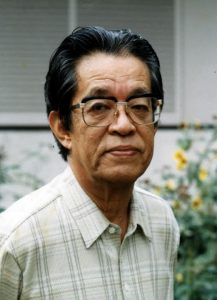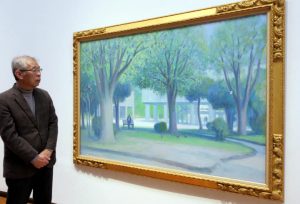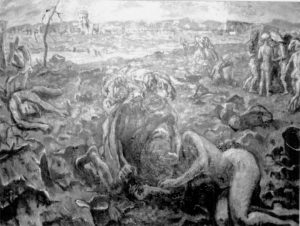An anti-nuclear life, Part 3: Teruo Niinobe (Western painter, 1922–2012)
Mar. 26, 2024
Halftones reflect tranquility
Artist expressed world that was the opposite of A-bombing
Teruo Niinobe, a Western-style painter from Hiroshima City, created elegant art works of pastel-colored landscapes based on his love of the sunlight he found in southern France. As a member of the Kofu-kai and Nichiyo-kai art schools, he actively engaged in the Nitten Exhibition (in English, ‘Japan Fine Arts Exhibition’) and mentored many younger artists.
Avoiding extremes in light and darkness and bright colors, Mr. Niinobe created a harmony of color by including subtle gradations of gray tones. He became known as a painter who used “halftone,” non-primary colors.
“Heiwa Koen Seijitsu” (‘Tranquil Day at Peace Park’) (1988), now on display in the collection exhibit at the Hiroshima City Museum of Contemporary Art (in the city’s Minami Ward), is characteristic of his painting style. The painting shows a scene of sunlight filtering through the trees in Peace Memorial Park, located in the city’s Naka Ward. The Hiroshima Peace Memorial Museum stands inconspicuously in the background.
Mr. Niinobe lost his parents in the atomic bombing, and he himself was exposed to radiation when he entered the city after the bombing. While standing in front of the painting, his second son, Yasuo Niinobe, 73, recalled memories of his father. “He never mentioned his A-bomb experiences to us. I only learned about them through essays he had written,” said the painter of Western-style works who is a resident of Hiroshima’s Saeki Ward. He added, “I don’t know whether the paintings can be called an expression of the A-bombed Hiroshima. But I guess we can say that what reveals itself in his tranquil paintings is Hiroshima.”
Mr. Niinobe’s family was in the kimono wholesaler and Western fabric business in downtown Hiroshima. His talent for painting was apparent from an early age, and he began holding solo exhibits of his oil paintings at the Osaka Takashimaya and Hiroshima Fukuya department stores at the age of 10. His parents’ support might have been a key to that early success, but his works from that time clearly justify the reputation he was gaining as a “child prodigy.”
He went on to study oil painting at the Tokyo School of Fine Arts (present-day Tokyo University of the Arts), where he studied under Kunzo Minami, who was a native of Kure City in Hiroshima Prefecture. As his family was of means, Mr. Niinobe started to consider studying in Europe.
However, war stood in the way of that accelerated track in the art world. The wartime atmosphere grew more intense even at the arts school, with its increased number of military training exercises. In the fall of 1943, he was forced to graduate early and discontinue his studies. The following year, he took up a teaching position in Hiroshima City.
On August 6, 1945, the day the atomic bomb was dropped on Hiroshima, he was at a medical facility in the suburbs of the city due to a chest ailment. He entered the city a few days later but was unable to find any trace of his father. One month later, his mother died of illness caused by radiation from the bombing.
Yasuo described the situation at that time. “The family business was not going well even before the end of the war, and the house was destroyed [in the bombing]. I think the family had a hard go of it.” For Mr. Niinobe, who was left standing amid the burned ruins of Hiroshima, his dream of studying abroad was suddenly a thing of the past.
An image of his work that represents his work shortly after the end of the war appeared in the Chugoku Shimbun. Titled “Tasogare” (‘Twilight’), the work was submitted by Mr. Niinobe to the 4th Nitten Exhibition in 1948, when he was in his mid-20s, resulting in his first award. The painting was introduced in the August 6, 1950, article that reported how Floyd Schmoe, an American peace activist who had built houses for A-bomb survivors in Hiroshima, was to bring the painting back to the United States and show it to the American public.
The painting clearly depicts the devastation of Hiroshima immediately after the atomic bombing. The newspaper photograph is in black and white, and therefore the painting’s colors can only be imagined. But the intense brushwork, which seems accusatory in nature, and the strong distinctions between light and dark appear to be in contrast with the style of his later paintings.
According to records, Mr. Niinobe created three successive paintings on the theme of the atomic bombing that he submitted to the Nitten Exhibition. Mr. Niinobe described the paintings in an essay he wrote in 1985. “Dr. Schmoe brought the first one back to the U.S., but I later tore up the second and third paintings. I was tired of continuing to paint and look at those hellish scenes.” Hoping to break new ground, he sought ways to express himself in other ways, including gentle images of a mother and child.
In 1964, when in his 40s, Mr. Niinobe was able to achieve his long-cherished desire to visit Europe. He spent nearly one year traveling in France and Spain among other countries. In 1977, he revisited a certain village in southern France, and the impressive scenery there made a decisive impact on his later work.
He became absorbed in sketching the scenery. In one of his essays, he described his feelings of elation. “Halftones reverberated dreamily in the sunlight that filtered through the leaves after a light rain,” he wrote. Repeated visits to the village resulted in his creation of numerous masterpieces.
Taisuke Teramoto, 85, former director of the Kure Municipal Museum of Art who was on friendly terms with Mr. Niinobe, considers his depictions of the atomic bombing to be “his most important work.” Mr. Teramoto said that Mr. Niinobe once confided to him that the woman and puppy in one of his paintings were a representation of his mother and himself. In complete contrast to the works he created of a world at peace and tranquility was the underlying theme of the atomic bombing, which destroyed his family and hometown.
In his later years, before the 50th anniversary of the atomic bombing, he painted a large work titled “Genbaku Ki Harukani” (‘Atomic Bomb Memorial Faraway’) (1994), which is displayed on a basement wall in the Hiroshima Peace Memorial Museum. The painting depicting the A-bomb Dome, a young girl, and the statue of Our Lady of Nagasaki conveys, in halftones, the beauty of harmony.
Teruo Niinobe
Born in Hiroshima’s Naka Ward, Mr. Niinobe graduated from the Tokyo School of Fine Arts. After the war, he led the Hiroshima Western Painting Institute and taught at Yasuda Women’s Junior College, among other schools. He served as a judge and trustee for the Nitten Exhibition and served as president of the Hiroshima Nitten Association, playing a leading role in local Western painting circles. He also authored Hidokei (‘Sundial’), a collection of essays.
(Originally published on March 26, 2024)










